The mining Community of Brynamman is split by the River Amman, which divides Upper and Lower Brynamman, and also acts as the boundary between the Counties of Carmarthenshire and Neath Port Talbot. All of the men of the village are remembered on this page. Many thanks to Wendy Edwards for the photo of the War Memorial. It will be noticed that the details of the WW2 Casualties are pretty vague at times. This is because of a more limited amount of material being readily available and no service papers in the public domain.
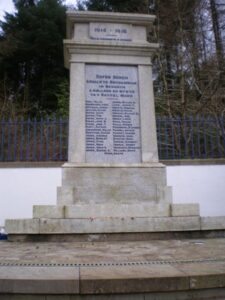
The Anglo Boer War, 1899-1902
David Jones, Gunner, 80442, Royal Field Artillery. David was born in Brynamman in about 1870 and was the brother of Mary Jones. He enlisted into the Royal Field Artillery on 1 September 1890 and was among the British troops sent to South Africa following the outbreak of the Boer War. David was killed at Ladysmith on 27 April 1900. He does not appear to be commemorated anywhere locally.
The Great War, 1914-1918
William Abel, Private, 13243, Royal Welsh Fusiliers. William was born at Birmingham in 1892. He lived with his brother Herbert at Park Street, Lower Brynamman prior to the war, and enlisted at Ammanford into the 10th Battalion, Royal Welsh Fusiliers. The Battalion was formed at Wrexham on 16 October 1914 as part of K3 and attached to 76 Brigade, 25th Division. They moved to Codford St Mary but by November 1914 were in billets in Bournemouth. They landed at Boulogne on 27 September 1915, and on 15 October 1915 transferred with 76 Brigade to the 3rd Division. They saw action South of Ypres at the St. Eloi craters, and then moved to the Somme sector where they fought through from the Battle of Albert, to the Battle of the Ancre, where William was Killed in Action on 13 November 1916, aged 24. His body was lost on the battlefield, and so he is remembered on the Thiepval Memorial, France.
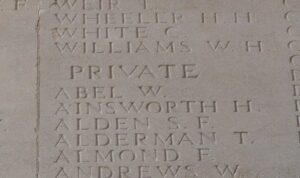
Frederick Burridge, Private, 57479, Royal Welsh Fusiliers. Fred was born at Shepton Mallet in 1886, the son of Sidney and Eva Burridge. He worked as a Coalminer, and moved to South Wales, where he lived for a while with his mother (who had been widowed and remarried), Eva Tapscott, at 23, Arnold Street, Mountain Ash. It is no known for certain, but Fred possibly worked at Brynamman prior to the war, and enlisted into the Army Service Corps, before being transferred to the 9th Battalion, Royal Welsh Fusiliers. The battalion was attached to 58 Brigade, 19th (Western) Division, and had taken part in most of the major battles since landing in France in June 1915. Fred survived the war, and remained in France after the armistice. The CWGC show that he died in France on 6 January 1919, aged 27. However, newly released soldiers effects papers show that he most likely was killed on 6 October 1918 and his death was presumed on the latter date. If that is the case then it makes sense that he is commemorated on the Vis-en-Artois Memorial, France. If he had died on the latter date he would have a known grave, as the war had ended.
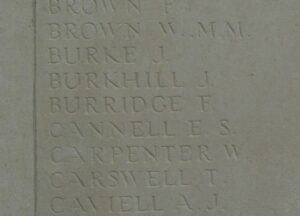
James Ernest Chapman, Private, 20054, Welsh Regiment. James was born at Newport Monmouth. He had initially moved to west Wales to work at Evans Nurseries, Mountain Road, Brynamman, and enlisted into the 15th Battalion, Welsh Regiment, which formed part of 114 Brigade, 38th (Welsh) Division. In the summer of 1915 the Battalion moved with the remainder of the Welsh Division to Morn Hill Camp, Winchester, where it completed its training and equipping, and embarked for France from Folkestone on 5 December 1915, disembarking at Boulogne the same day. During the winter and spring of 1916 the Battalion held nearly every section of the British line from Givenchy on the La Bassée Canal to Laventie, about six miles South of Armentières. At the end of May, 1916, the Battalion moved South with the remainder of the 38th (Welsh) Division to the Somme area, in readiness for the First Battle of The Somme, which commenced on 1 July 1916. The Division were tasked with the taking of the infamous Mametz Wood. The first attack on Mametz Wood was on 7th July, when the division lost heavily in ‘Death Valley’ during the advance on the ‘Hammer Head’. The next attack went in on 10 July, and by 11 July the wood was cleared, but at the cost of over 5,000 casualties in the 38th (Welsh) Division. James was killed in action during the initial charge into the wood on 10 July 1916, although his official date of death is the following day. He is buried in Caterpillar Valley Cemetery, Longueval, France.
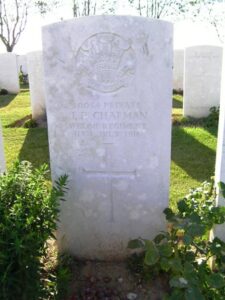
William Hayden Cowling, Gunner, W/4677, Royal Field Artillery. William was born at Llandilofawr in 1890, the son of Philip Henry and Sarah Cowling. He worked as a Collier at Brynamman prior to the war, and enlisted at Ammanford into the Royal Field Artillery. He was attached to the 122nd Brigade Head Quarters, attached to the 38th (Welsh) Division. It is not known if he arrived in France with the Division in December, 1915, but he was with them in 1918 when the German Offensives were launched on the Western Front, and he was Killed in Action during the Battle of the Selle, after the Hindenburg Line had been broken, on 26 October 1918. He is buried at Romeries Communal Cemetery Extension, France.
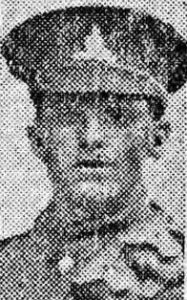
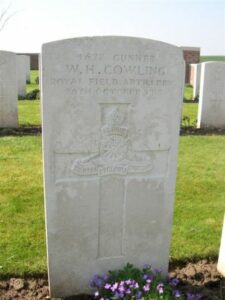
Isaac Davies, Private, 33756, Welsh Regiment. Isaac was born in 1884, the son of Isaac Davies and Anne Davies (nee Jones), of Blaenina, Llanybydder. He left home to find work as a coal miner as a young man and by 1911 was lodging with his brother Thomas and his family at Haulybryn, Llandeilo Road, Brynamman. Isaac married Sarah Jones at Brynamman in the spring of 1914 and the couple set up home together at Trehyfryd House, Llandiloe Road, Brynamman, where their daughter Marian was born later that year. Isaac enlisted at Brynamman into the 8th Battalion, Welsh Regiment in the spring of 1915. The battalion was at Aldershot and was the Pioneer Battalion to the 13th (Western) Division. On 13 June 1915 the Division sailed for the Mediterranean, and during July 1915 landed on Cape Helles, relieving the 29th Division, before moving to ANZAC Cove from 3 August 1915, taking part in the Battles of Sari Bair, Russell’s Top, and Hill 60, ANZAC. Soon afterwards the Division was transferred from ANZAC to Suvla Bay, and it was evacuated from Suvla on 19 December 1915, transferring to Helles. On 8 January 1916, the Division was evacuated from Helles, and by 31 January was concentrated at Port Said, where they held forward posts in the Suez Canal defences. On 12 February 1916 the Division began to move to Mesopotamia, to strengthen the force being assembled for the relief of the besieged garrison at Kut al Amara. Isaac took ill soon afterwards and was evacuated via Hospital Ship to Bombay. He died of dysentery in Bombay on 22 August 1916. The 35-year-old was originally buried in Sewri Cemetery, Bombay, but in 1962 the war graves in the cemetery were exhumed and re-interred in Kirkee War Cemetery, India.
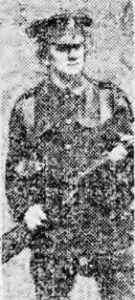
Thomas Davies, Private, 242011, Welsh Regiment. Thomas was born in Llangadock, and was the Foster son of Mrs. Mary Evans, of Cwoncaemawr, Cwmgarw Road, Brynamman. He enlisted at Brynamman into the 18th Battalion, Welsh Regiment, which formed part of 119 Brigade, 40th (Bantam) Division. The Division moved to France in early June, 1916, and served in the Loos area, before moving to the Somme late in 1916, where they took part in the Battle of the Ancre. They then followed the German retreat to the Hindenburg Line, and fought during the Battle of Cambrai, fighting at Bourlon Wood, before moving South to the St. Quentin area in early 1918. It was here, on 21 March 1918 that part of the German Spring Offensive was launched. The fighting was terrible, with many British Battalions being simply wiped out. The Division were rushed back to Flanders, and took part in the Battle of the Lys, where Thomas was Killed in Action on 10 April 1918, aged 29. His body was lost in the course of the battle, and so he is remembered on the Ploegsteert Memorial, Belgium.
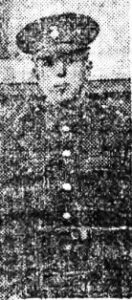
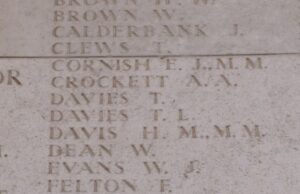
David John Evans, Private, 75286, Welsh Regiment. David was born in Brynamman, the son of James and Gwen Evans, of Waunhen, Cwmgarw Road. He enlisted at Cardiff on 3 May 1918 into the 3rd Battalion, Welsh Regiment, and on 16 September 1918 landed in France, where he was posted to the 15th Battalion, Welsh Regiment. The battalion was known as the Carmarthen Pals battalion, and had been in France since December 1915 attached to 114 Brigade, 38th (Welsh) Division. David joined the battalion after it had launched its assault against the Germans on the Somme, and joined up with the battalion near Manancourt, near the Canal du Nord. After playing a leading role in pushing the Germans back in late 1918, the battalion took part in the Battle of the Selle, near Cambrai. David was killed in action here on 23 October 1918, aged just 20. He is buried at Rocquigny-Equancourt Road British Cemetery, Manancourt, France.
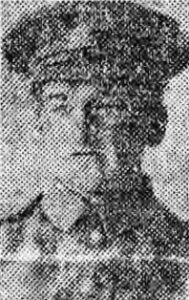
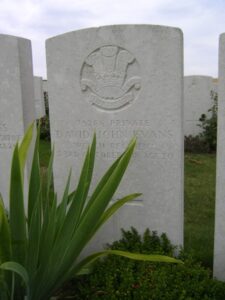
John Evans, MM, Corporal, 13485, Royal Welsh Fusiliers. John was born at Brynamman, the son of William Thomas Evans and Sarah Evans, of 36, Glyn Road, Lower Brynamman. He enlisted at Ammanford into the 9th Battalion, Royal Welsh Fusiliers, who formed part of 58 Brigade, 19th (Western) Division. The Division had crossed to France during July, 1915 and saw its first action during the Battle of Loos. They then moved to the Somme, where they took part in the second wave of the attack on Ovillers-La Boisselle, capturing the village at heavy cost, and fought through the Somme Battles of 1916. They then moved North to Ypres, taking part in the Battle of Messines, and fought on the Menin Road and at Polygon Wood, before moving up to Passchendaele Village itself. In 1918 they were caught up in the German Spring Offensive near St. Quentin, where they suffered terrible casualties. They moved to Ypres, but were caught up in the German attack at Messines, and at Kemmel where John was Killed in Action on 29 April 1918, aged 30. He is remembered on the Tyne Cot Memorial, Belgium. John was the holder of the Military Medal, for Bravery in the Field.
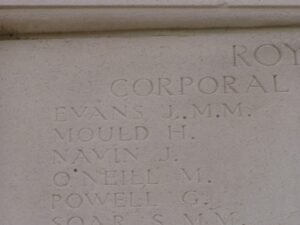
John Walter Evans, Private, 31405, Royal Welsh Fusiliers. John was the son of John and Sarah Evans of Rhydcais, Lampeter. He worked as a Collier at Brynamman prior to the war, and enlisted at Ammanford into the 16th Battalion, Royal Welsh Fusiliers, who were attached to 113 Brigade, 38th (Welsh) Division. The Division moved to France in December, 1915 and moved to positions in the Nursery Sector near Armentieres. Here they trained in trench warfare in a so-called quiet sector, but even this was dangerous, as John was wounded here. He was evacuated to the Base Hospital at Rouen, where he died of wounds on 22 March 1916, aged just 22. John is buried at St. Sever Cemetery, Rouen, France.
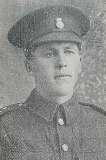
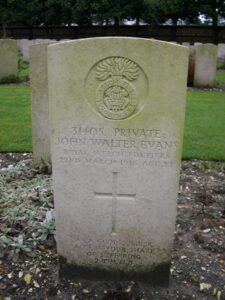
Patrick Fahey. This man cannot presently be identified but he lived with his wife and three children at Chapel Street, Brynamman and in March 1919 was in hospital in Birmingham, after having been gassed two years earlier. He was likely to be a man named William Fahey (also named Faye) who served with a Tunnelling Company of the Royal Engineers and was invalided firstly to Grove Road Hospital, London.
William Jenkin Greenwood, Private, 13105, Welsh Regiment. William was born in Llandovery, the son of William and Margaret Greenwood. The family later resided at Llanarthinna, Quarry Road, Brynamman. William enlisted at Carmarthen into the 2nd Battalion, Welsh Regiment, part of 3 Brigade, 1st Division. The Division had been one of the first to arrive in France, fighting at the Battle of Mons, and taking part in the retreat to the Marne, where the Germans were stopped. They then fought at the Aisne, and at Chivy, before being moved North to Ypres. Here they fought at the First Battle of Ypres, where they again stopped the German Offensive, before wintering in Flanders. The following year saw them in action again at the Battle of Aubers, before moving South to Loos, where they fought during the Battle of Loos, and the action at the Hohenzollern redoubt. William was Killed in Action at Loos on 12 October 1915 aged 23. He was buried at Crucifix Cemetery near Loos, but when the cemetery was destroyed by gunfire in further fighting in the area, his grave was lost. William is now commemorated by a Special Memorial inside Dud Corner Cemetery, Loos, France.
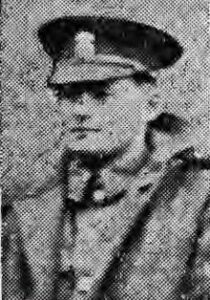
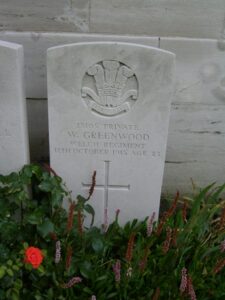
William Rufus Griffiths, Private, S/9823, Seaforth Highlanders. William was the son of William and Margaret Griffiths, of 9, Glyn Road, Brynamman. He was employed at the Glynbeudy Tinplate Works as a tinman, and enlisted at Ammanford into the army. William was posted to the 1st Battalion, Seaforth Highlanders. The Battalion was part of the Dehra Dun Brigade, 7th (Meerut) Division of the Indian Army based in India at the outbreak of war. They landed at Marseilles on 12 October 1914, and saw action during the Battle of Neuve Chapelle and at Aubers Ridge, before attacking at Pietre as a diversion to the main Loos Offensive. By December 1915 the Division were on the move again, being sent to Mesopotamia, landing at Basra on 31 December 1915. After reorganising, the Division took part in the attempt to relieve the besieged town of Kut al Amara, The relief failed, but the war kept on in Mesopotamia, where William was Killed in Action on 17 July 1916, aged only 19. He is buried at Amara War Cemetery, Iraq.
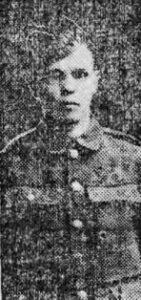
Lewis George Hodson, Private, 14518, Royal Army Veterinary Corps. Lewis was born at Boyle, Ireland on 24 October 1872, the son of Thomas and Margaret Hodson. The family later moved to Brecon, and Lewis began working in the mines around Ystradgynlais and Brynamman. He married in 1907, and resided with his wife, Kate Hodson, at Cwmgarw Road, Brynamman. Lewis had served with the 2nd Battalion, South Wales Borderers (Mounted Infantry) in the South African Campaign, and re-enlisted in 1914, serving in the Royal Army Veterinary Corps. There are no records of his service, but he was Gassed on the Western Front at some time during the war, and was brought home for treatment. Lewis sadly Died of Wounds suffered from Gas Poisoning on 11 July 1920, aged 47, and is buried at Brecon (St. David) Churchyard. Lewis is not commemorated at Brynamman.
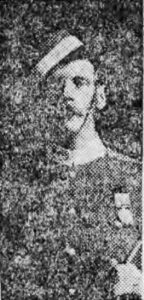
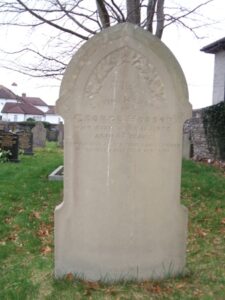
Ernest Arthur James, Private, 63848, Royal Welsh Fusiliers. Ernest was the son of Frederick George and Mary Jane James, of 18, Park Road, Brynamman. He had been born at Ruabon, Denbighshire, and enlisted at Wrexham into the Royal Welsh Fusiliers. Ernest was sent to the Middle East to join the 24th Battalion, Royal Welsh Fusiliers, which was attached to 231 Brigade, 74th (Yeomanry) Division. Ernest was unluckily sent out on the SS Cameronia, a requisitioned passenger liner, which was being used to carry troops from Marseilles to the Middle East. He drowned when Cameronia was torpedoed and sank, about 150 miles from Malta, by the German Submarine U33 on 15 April 1917, with the loss of 200 lives. Ernest was 20 years old, and is commemorated on the Mikra Memorial, Greece. Ernest is not listed on the Brynamman War Memorial.
Aneurin Jones, Gunner, 100768, Royal Garrison Artillery. Aneurin was born in Llandeilo, the son of Thomas and Mary Jones. He later resided at Marlais Villa, Llandilo Road, Brynamman, and worked as a coal miner. Aneurin enlisted at Carmarthen into the Royal Garrison Artillery, serving in their 110th Heavy Battery, as part of the 7th (Meerut) Division in the Indian Army. After returning to Europe from service in India, they landed at Marseilles on 12 October 1914, and saw action during the Battle of Neuve Chappelle and at Aubers Ridge, before attacking at Pietre as a diversion to the main Loos Offensive. By December 1915 the Division were on the move again, being sent to Mesopotamia. The 110th Heavy Battery were posted to the 67th Brigade, R.G.A. on 6 March 1915 and remained on the Western Front, and took part in the Battles of Third Ypres. Aneurin was Killed at Third Ypres, during the Battle of Pilckem on 2 August 1917, aged 24. He is buried at Vlamertinghe New Military Cemetery, Belgium.
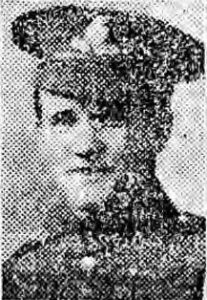
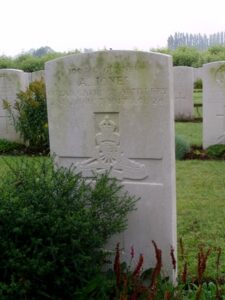
Brinley Jones, Private, 129361, Machine Gun Corps. Brinley was born in Brynamman, the son of Thomas and Hannah Jones, of Stafford House, Station Road. He enlisted at Carmarthen into the Monmouth Regiment, but was later posted to the 55th Battalion, Machine Gun Corps, probably upon the formation of the Corps in 1916. The 55th Battalion were the Machine-Gunners to the 55th (West Lancashire) Division, who had been formed in France from Territorial Units in January, 1916. The Division first fought at Arras, before being moved to the Somme in July 1916, where they fought for two months before moving to Flanders. Here they fought at the Battles of Pilckem and the Menin Road, before moving to Cambrai to take part in the offensive there in November, 1917. After being annihilated at Cambrai, the Division were withdrawn from the line, and not used until the desperate days of the Spring of 1918, when the German Offensive had smashed the British Lines on the Western Front. The Division moved to the Givenchy area, where it was hit during the first day of the German offensive on the Lys, on 9 April 1918. Brinley was killed in action during the heavy fighting that day. He was 19 years old and is buried at Gorre British & Indian Cemetery, France. His brother Cyril also fell.
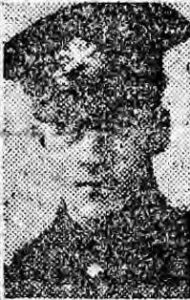
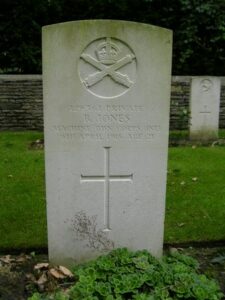
Cyril Jones, Private, 15338, Royal Welsh Fusiliers. Cyril was the son of Thomas and Hannah Jones, of Stafford House, Station Road, Brynamman. He enlisted at Ammanford into the 10th Battalion, Royal Welsh Fusiliers, part of 76 Brigade, 3rd Division. The Battalion had originally landed at Boulogne on 27 September 1915 in 25th Division, but transferred with the Brigade into the 3rd Division just a few weeks after landing. This Division had been in France since the start of the War, and was stationed near Ypres in the Autumn of 1915. They fought throughout the Winter of 1915/1916 at Bellewaarde, and moved to St. Eloi at the beginning of the New Year, where Cyril was wounded. He Died of Wounds on 22 February 1916, aged just 21, and is buried at Lijssenthoek Military Cemetery, Belgium. His brother Brinley also fell.
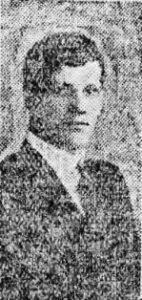
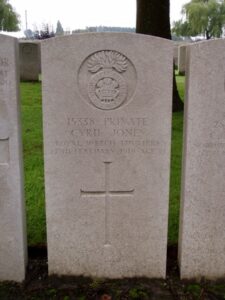
John Jones, Private, 8202, Dorsetshire Regiment. John was born in Caernavon, and resided in Brynamman prior to the war, with his sister, Mrs. Margaret Morgan, of Cwmgarw Road, Brynamman. He enlisted at Ynyshir into the 1st Battalion, Dorsetshire Regiment, part of 15 Brigade, 5th Division. They were amongst the first British Division in France, and saw action at the Battle of Mons, and the retreat down through Le Cateau, the Marne, and the advance to the Aisne. They then moved North to La Bassée, and fought at Messines in late 1914, assisting the Defence of Ypres, during the Battle of First Ypres. They were still there for the Battle of Second Ypres, but in late 1915 the 1st Dorsets were transferred into 95 Brigade, 32nd Division. The Division fought during the Battles of the Somme from July 1916 onwards, so it is strange that when John was Killed in Action on 9 August 1916, that he was buried in Cambrin Churchyard Extension, which is much further North. He was 41 years old. John is not commemorated at Brynamman.
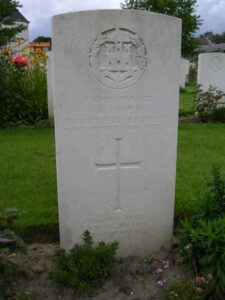
Noah Jones, Private, 34129, Worcestershire Regiment. Noah was born in Llanguicke, the son of Walter and Mary Ann Jones, of 8, School Road, Lower Brynamman. He enlisted at Ammanford into the army, and was posted to the 4th Battalion, Worcestershire Regiment, part of 88 Brigade, 29th Division. The Division was formed in early 1915, and sent to Egypt soon after. From here, they landed on Cape Helles on 25 April 1915, and saw heavy action here until evacuated on 2 January 1916. They moved to France, landing at Marseilles on 29 March 1916 and took part in the opening of the Battle of the Somme, at Beaumont Hamel. They later moved to Arras, where they fought in the Battles of the Scarpe, which is where Noah was Killed in Action on 23 April 1917, aged just 20. He is buried at Windmill British Cemetery, Monchy-Le-Preux, France.
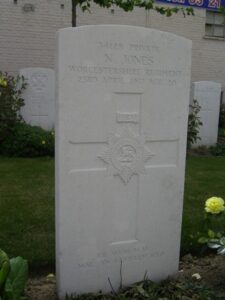
Rhys Herbert Jones, Private, 269834, Notts & Derby (Sherwood Foresters). Rhys was the son of William and Gwenllian Jones, of Cwmnantmoel Farm, Brynamman. He worked as a Draper in London, and enlisted at Mill Hill, Middlesex into the army, being posted to the 1/5th Battalion, the Sherwood Foresters, who formed part of 139 Brigade, 46th (North Midland) Division. The Division moved to France in February, 1915 and fought at the Hohenzollern Redoubt. The Division was ordered to proceed to Egypt in December, 1915 but after arrival, were sent back to France, and moved to the Northern Somme area, where they took part in the main diversionary attack to the Somme Offensive, at Gommecourt. They suffered heavy casualties, and moved South to the Ancre Valley, where they over-wintered, before following the German retreat to the Hindenburg Line in early 1917. They then fought at Hill 70 during the Battle of Arras, and moved North to French Flanders, where they helped repel the German Offensive of Spring, 1918. Rhys was wounded during this period, and sadly Died of Wounds on 19 April 1918 in Flanders. He was 37 years old, and is buried at Cambrin Military Cemetery, France.
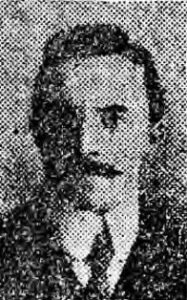
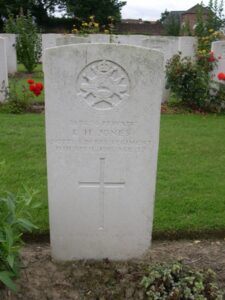
Samuel Gordon Jones, Lance Corporal, 17272, Welsh Regiment. Gordon was born at St. Clears, the son of Spencer Jones. The family was residing at 3, Amman Road, Brynamman prior to the war, although Gordon lived with his wife, Dorothy Jones, at 126, Eaton Road, Brynhyfryd, Swansea. He enlisted at Swansea into the 14th Battalion, Welsh Regiment, known as the Swansea Pals, which moved to France in December 1915 with 114 Brigade, 38th (Welsh) Division. During the winter and spring of 1916 the Battalion held nearly every section of the British line from Givenchy on the La Bassée Canal to Laventie, about six miles South of Armentières. At the end of May 1916, the Battalion moved South with the remainder of the 38th (Welsh) Division to the Somme area, in readiness for the First Battle of The Somme, which commenced on 1 July 1916. The 38th Division was tasked with the taking of the infamous Mametz Wood. The first attack on Mametz Wood was on 7 July, when the division lost heavily in ‘Death Valley’ during the advance on the ‘Hammer Head’. The next attack went in on 10 July, and after heavy fighting the wood was cleared, but at the cost of over 5,000 casualties in the 38th (Welsh) Division. Gordon was wounded during the first attack on 10 July, and was brought back to the Casualty Clearing Station at Daours, where he sadly Died of Wounds on 11 July 1916 aged 24. He is buried in Daours Communal Cemetery Extension, France.
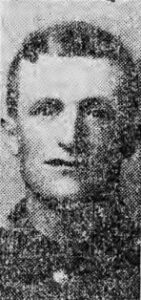
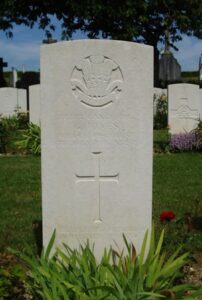
William Arthur Jones, Private, 13241, Royal Welsh Fusiliers. William was the son of William and Hannah Jones, of 11, School Street, Lower Brynamman. Prior to the war William was a member of the Brynamman Fife Band, and when he enlisted at Ammanford into the 9th Battalion, Royal Welsh Fusiliers he became a Drummer in the Battalion. The Battalion was part of 58 Brigade, 19th (Western) Division. The Battalion landed at Boulogne on 19 July 1915 and fought during the Battle of Loos, where William was posted as killed in action and missing during the initial assault of 25 September 1915. He was 27 years old, and is commemorated on the Loos Memorial, France.
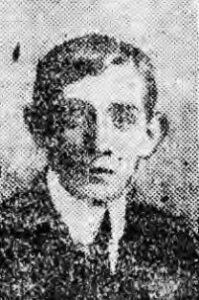
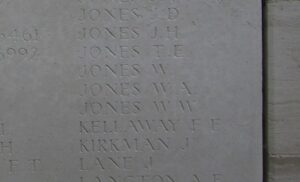
John David Lewis, Private, 58428, South Wales Borderers. John was the son of David and Elizabeth Lewis, of Cwmbrobil, Brynamman. He enlisted at Cardiff into the army, and was posted to the 2nd Battalion, South Wales Borderers. At the outbreak of war, the 2nd SWB was in China, and fought a Battle there at Tientsin, before being sent via the UK to Gallipoli, where they landed at Cape Helles on 25 April 1915. It is doubtful if John served here, but after evacuation on 2 January 1916 the Battalion moved, as part of 87 Brigade, 29th Division, to Marseilles via Egypt. In France they fought on the Somme in July 1916, and took part in the Battle of Arras in 1917, fighting at the Scarpe. Later that year they moved to Ypres, taking part in the Battles of Langemarck, the Menin Road, Polygon Wood, Broodseinde and Poelcappelle, before again moving and fighting during the Cambrai Offensive. They were caught in the German Spring Offensive of March 1918 onwards, fighting in French Flanders. Later that year the division took part in the advance eastwards toward Courtrai, and it was during this offensive when John was Killed in Action on 15 October 1918. He was just 22 years old, and is buried in Dadizeele New British Cemetery, Belgium.
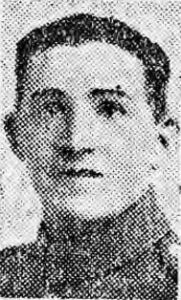
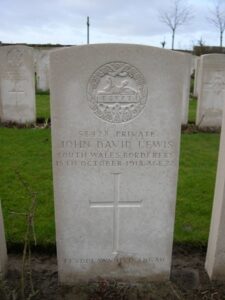
Morgan Morgan, Private, S/14869, Gordon Highlanders. Morgan was the son of Dafydd and Mary Ann Morgan, of 1, Park Lane, Lower Brynamman. He was one of four Brynamman men who had enlisted at Ammanford into a Scottish regiment, and joined the 9th Battalion, Gordon Highlanders, which formed part of 44 Brigade, 15th (Scottish) Division. In July 1915 the Division landed in France, and saw their first action at the Battle of Loos, remaining in the area around Hulloch in Spring, 1916 where they suffered gas attacks by the Germans. Morgan was Killed in Action on 26 June 1916, aged only 19, and is buried at Vermelles British Cemetery, France.
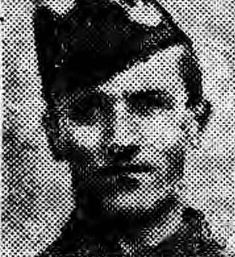
Thomas Vivian Morgan, Private, S/9809, Seaforth Highlanders. Vivian was the son of John and Esther Ann Morgan, of Cartref Clyd, Mountain Road, Brynamman. He was a schoolteacher before enlisting in January 1915 into the 4th Welsh, but was later found to be underage and was discharged. Vivian then re-enlisted, and served in the 7th Battalion, Seaforth Highlanders, which formed part of 26 Brigade, 9th (Scottish) Division. The Division had arrived in France by June 1915 and fought at the Battle of Loos. They then fought during the Somme Battles, capturing Longueval, where Vivian was wounded by shrapnel, which passed through both his legs. He was carried to a Casualty Clearing Station by two German Prisoners, and after recovering from his wounds returned home for a short spell, before going back to the front. The Division were now in the Arras Sector. Here they fought in the Battles of the Scarpe, before again being moved, this time to Ypres, where they took part in the Battle of the Menin Road, and the First Battle of Passchendaele. Vivian was killed in Action at Passchendaele on 12 October 1917, aged only 19. His body was lost in the Flanders mud, and so he is remembered on the Tyne Cot Memorial, Belgium.
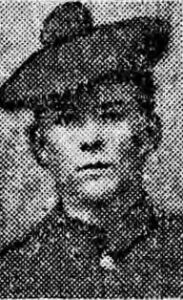
William Benjamin Beddoe Morgan, Private, 292052, Royal Welsh Fusiliers. William was born on 21 February 1892, the son of Morgan Morgan and Margaret Morgan (nee Beddoe), of 6, Linthorpe Terrace, Danygraig Road, St. Thomas, Swansea. He worked as a clerk at Brynamman prior to enlisting into the army there on 10 December 1915. William was initially placed on the Army Reserve and was mobilised on 29 August 1916, joining the 2/7th Battalion, Royal Welsh Fusiliers, which was a home service unit, attached to 203 (2nd North Wales) Brigade, 68th (2nd Welsh) Division. On 5 July 1917 William was drafted to France, joining the 13th Battalion, Royal Welsh Fusiliers, which was attached to 113 Brigade, 38th (Welsh) Division. The division had been in France since December 1915, and in July 1916 had made its famous assault on Mametz Wood. The battered division was then moved to Ypres, taking up the line at Boesinghe, along the Yser Canal, where the infantry battalions of the Division had been busy, working on trench improvement, digging new trenches, and also carrying out regular patrols and trench raids, prior to launching its famous assault upon the Pilckem Rodge on 31 July 1917, capturing Iron Cross and reaching its objective of the Steenbeek. The division then played a supporting role in the Battle of Langemarck, before transferring to the Sailly-sur-la-Lys sector in September, and remained in the area over the winter before being moved to positions north of Albert, at Bouzincourt Ridge, at the end of March 1918, relieving the battered 2nd and 47th Divisions. It held this sector, again carrying out minor operations and trench raids, over the coming months, before taking part in the great offensive of 21 August 1918, and began its advance towards the Hindenburg Line. Over the coming days the division captured Thiepval Ridge, Pozieres, Mametz Wood and High Wood, whilst advancing across the old Somme battlefields of 1916. William was killed in action on 29 August 1918, during an assault by the 13th RWF from the direction of Delville Wood towards Ginchy. The 25-year-old has no known grave so is commemorated on the Vis-En-Artois Memorial, France.
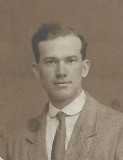
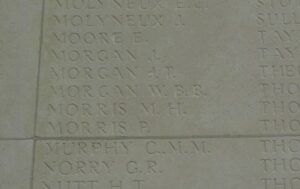
Joel William Morris, Gunner, W/1386, Royal Field Artillery. Joel was the son of Rees and the late Sarah Morris, of Rose Cottage, Queen Street, Aberystwyth. He worked at Brynamman, and enlisted at nearby Ammanford into the Royal Field Artillery, serving in their ‘B’ Battery, 122nd Brigade, attached to the 38th (Welsh) Division. On 5 December 1915, the Division disembarked at Boulogne, and during the winter and spring of 1916 held the line in French Flanders, before moving south to the Somme, where they fought at Mametz Wood. After a year in reserve, they fought at Pilckem Ridge and Langemarck in Third Ypres, which is where Joel was Killed in Action on 14 August 1917 aged 24. He is buried in Canada Farm Cemetery, Belgium.
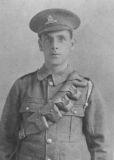
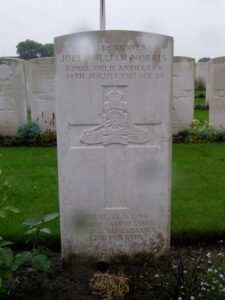
Evan Moses, Private, 12463, Royal Welsh Fusiliers. Evan was the son of Evan and Margaret Moses, of 18, Tinman’s Row, Brynamman. He served in the Royal Welsh Fusiliers during the Great War, and contracted frostbite during service at Gallipoli in 1915. After recuperating in Hospital in Malta, Evan returned to his unit which was now in Palestine, but he contracted Malaria there, and was brought back home for treatment. Evans’ health deteriorated, and he married Mariah Elizabeth Evans at Cardigan on 25 February 1922. Evan died of malaria on 15 December 1922, aged 30, and is buried at Lower Brynamman (Siloam) Baptist Chapelyard, in the grave of his brother Lewis (below). He left a wife and child behind. Evan is not commemorated on the Brynamman memorial.
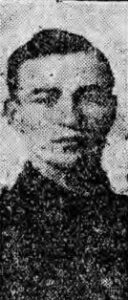
Lewis John Moses, Private, 20918, Welsh Regiment. Lewis was the brother of Evan (above), the son of Evan and Margaret Moses, of 18, Tinman’s Row, Brynamman. He enlisted at Ammanford into the 15th Battalion, Welsh Regiment, known as the Carmarthen Pals battalion, which landed in France in December 1915 attached to 114 Brigade, 38th (Welsh) Division. The Division was sent to the area around Armentieres to familiarise themselves with trench warfare, before moving to the Somme in June 1916 to take part in the assault on Mametz Wood. The first wave of the attack went in on 7 July 1916, with the wood finally falling a week later. Lewis was wounded during the attack, receiving a gunshot wound to his spine, and was brought home, via the network of Casualty Clearing Stations and Base Hospitals to Southampton. He sadly succumbed to his wounds and died at Netley Military Hospital, Hampshire on 4 August 1916. His body was brought home to Brynamman, and he was buried on 8 August at Lower Brynamman (Siloam) Baptist Chapelyard. His grave is now shared with his brother Evan.
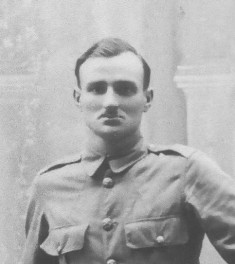
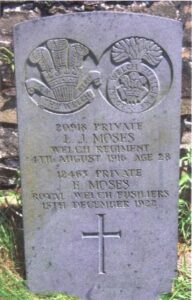
Phillip Owen, Private, 1167, Australian Infantry. Phillip was the son of John and Anne Owen, Sunny View, Lower Brynamman. He had served an apprenticeship in Swansea as a Carpenter, and decided to emigrate to Australia with his brother Morgan in around 1910/11. The brothers set up home at Dorrigo, New South Wales, and had settled into life in the New World well. But in August 1914 the former British Colony of Australia was called upon to help defend the Empire, when Britain declared war on Germany. On 14 October 1914 Phillip enlisted at Rosehill into the 4th Battalion, Australian Imperial Force. The nucleus of the Battalion had already been formed, and so Phillip became part of the 1st reinforcements to the Battalion. The original Battalion left Sydney on 20 October 1914, bound for Egypt. Phillip sailed later with the 1st reinforcements, and joined the Battalion at Mena Camp, Egypt on 7 February 1915. The Battalion then spent the next few months training in Egypt in preparation for a move to the Western Front, but it had been decided to open up a second front against Turkey, and so the Battalion moved to Mudros in the Mediterranean, and from there made a landing under heavy fire on the shores of Gallipoli on 25 April 1915. Phillip survived the Battalions famous charge at Lone Pine, but was taken ill on 23 August 1915 and evacuated to Mudros, and then to England for treatment. On 6 March 1916 he rejoined the Battalion in Egypt, and on 23 March the Battalion shipped to Marseilles, where they joined the BEF on the Western Front. The Battalion formed part of the 1st Brigade, 1st Australian Division, and moved to positions in the Nursery Sector near Fleurbaix and Fromelles. In July 1916 the Battle of the Somme opened, and the 1st Australian Division were brought south to the Somme, where they took part in the Battle of Pozieres. The Division managed against all the odds to capture the German positions on Pozieres Ridge, and were moved to Warloy Baillon for a rest. On 17 August 1916 the Division was brought back into the line, and took up positions south of Mouquet Farm. The farm was a formidable German stronghold, the capture of which was vital to the British plans to roll north and capture the German positions at Thiepval. On the following day the 4th Battalion attacked Mouquet Farm, but were repulsed at a heavy cost in lives. They tried again over the following days, but were again held and were brought out of the line on 21 August after suffering terrible losses. Phillip had been reported missing during the attacks on Mouquet Farm [along with my Grandfather], and it was a few days later that he was officially recorded as being killed in action on 19 August 1916. He was 28 years old, and is remembered on the Villers Brettoneux Memorial, France.
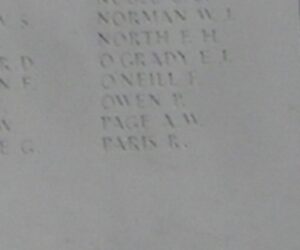
William George Peale, Private, 30005, Welsh Regiment. William was the son of Sarah Annie Atterbury (formerly Peale), of 16, Church Road, Ramsgate, and the late William Peale. He had been raised by Gomer Harries, of Penybont, Brynamman, before enlisting at Ammanford into the Welsh Regiment. He was posted to the 1st Battalion, Welsh Regiment, which was part of the Meerut Division in India at the outbreak of war. They returned to England, where they were attached to 84 Brigade, 28th Division, and landed in France, at Le Havre, during January 1915. Their first action was at Second Ypres, where terrible casualties were suffered. After a brief spell as a constituted Battalion, after the losses at Ypres, the 1st Welsh were reinforced and sent to Loos with the Division. Here they fought at the Battle of Loos, which is where William was Killed in Action, on 2 October 1915, aged only 18. He is remembered on the Loos Memorial, France.
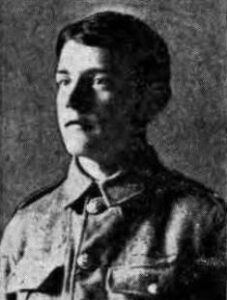
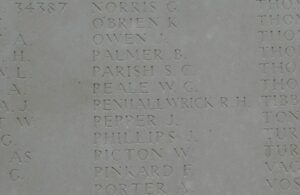
Stephen George Peregrine, Private, 70205, Machine Gun Corps. Stephen was born in Meline, Pembrokeshire in 1878, the son of Stephen George Peregrine and Maria Peregrine. By 1904 he was residing at Brynamman, and that year married Margaret, the couple setting up home at 22, Park Road, Brynamman. Stephen enlisted at Brynamman into the 9th Battalion, Welsh Regiment on 26 May 1915. He joined the battalion in France later that year, as part of a number of reinforcements after the Battle of Loos, and was transferred into the 58th Company, Machine Gun Corps upon the organisation of the MGC in 1916. The 58th Company was attached to the 19th (Western) Division, and Stephen would have served through the Battles of the Somme in 1916. The division fought at Messines, Polygon Wood, Broodseinde, Poelcappelle and Passchendaele during Third Ypres, and gained itself a reputation as a fine fighting force. During the winter of 1917-1918 the division was stationed near Bapaume, and was hit by the German offensive on 21 March 1918. The Division suffered heavily during the first few days of the attack, and Stephen was Killed in Action during the defence of Beugny, on 26 March 1918, aged 39. He is buried at Delsaux Farm Cemetery, Beugny, France.
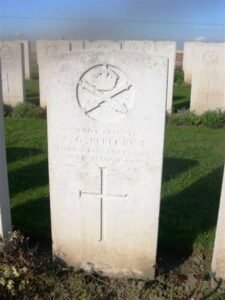
Arthur Powney, Private, 8162, Welsh Regiment. Arthur was born at Lacock, Wiltshire in 1885, the son of John and Elizabeth Powney. By 1891 his family had moved to Swansea Arthur married Gwen Evans prior to 1911, and resided with her and her family at 26, Glyn Road, Brynamman. He enlisted at Cardiff into the 2nd Battalion, Welsh Regiment and landed with the battalion in France on 13 August 1914, where they were attached to 3 Brigade, 1st Division. Their first action was at the Battle of Mons, and the subsequent retreat to the Marne, where the German attack was halted. Over the coming weeks the Welsh fought in several important battles, most notably the Battles of the Marne and the Aisne, where the German drive on Paris was halted. The Division then moved to Ypres, and took part in the First Battle of Ypres, where once again they helped stem the German drive to the Channel Ports. Arthur was wounded after a German gas attack at Ypres, and returned home for treatment. He sadly died of gas poisoning at Kings Norton, Warwickshire on 23 May 1915, aged 29. Arthur was buried with full military honours at Upper Brynamman (Gibea) Welsh Congregational Burial Ground.
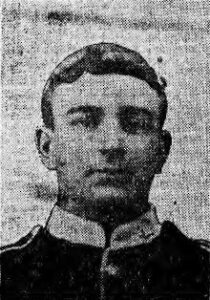
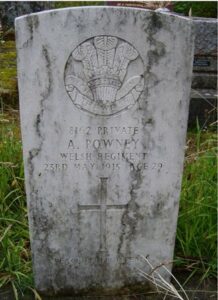
George Henry Powney, C.Q.M.S., 144110, Royal Welsh Fusiliers. George was the brother of Arthur (above), and was born at Swansea, the son of John and Elizabeth Powney. Prior to the war he resided with his wife Cecile Gladys Powney, at Cwm-Garw Road, Upper Brynamman. George enlisted at Swansea into the 11th Battalion, Royal Welsh Fusiliers, part of 67 Brigade, 22nd Division. The Division crossed to France in September 1915, and concentrated around Flesselles, but on 27 October the Division was ordered to Salonika, arriving there during December, 1915. At Salonika they fought during the Battles of Horseshoe Hill, Machukovo, and at Doiran, and at sometime here George took ill. He returned home to the UK for treatment, but his condition worsened, and George sadly Died of Sickness on 9 December 1917, aged 28. He is buried at Upper Brynamman (St. Catherine) Churchyard.
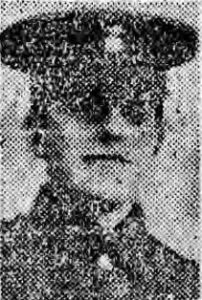
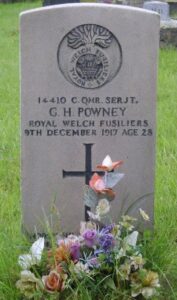
Uriel Roberts, Private, 13104, Welsh Regiment. Uriel was the son of John and Esther Roberts, of Pantycelyn, Lower Brynamman. He enlisted at Carmarthen into the 2nd Battalion, Welsh Regiment, which formed part of 3 Brigade, 1st Division. The Division had been one of the first to arrive in France, and fought at the Battle of Mons, then at the rearguard actions at the Marne, where the Germans were held. The Division followed the German withdrawal to the Aisne, where they met them head on, and inflicted heavy casualties on the Germans. This action stopped the German advance to Paris, and helped form the Western Front. The Division were moved to Ypres, where they again held a German attack on the ancient City, and they remained at Ypres that winter, holding their hard won lines. On 9 May 1915 the Division took part in the Battle of Aubers, which was designed to relieve the pressure on the French Armies. Uriel was Killed in Action on this first day of the offensive, on 9 May 1915. He was only 19 years old, and his body was lost on the battlefield, so he is remembered on the Le Touret Memorial, Richebourg L’Avoue, France.
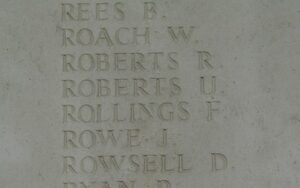
Rees Stanton, Private, 24459, Welsh Regiment. Rees was born in 1884, the son of Perry and Elizabeth Stanton, of 1, Club Cottage, Llangammarch Wells. He resided at Brynamman prior to the war, and enlisted at Cwmgorse into the 19th Battalion, Welsh Regiment, the Pioneer Battalion to the 38th (Welsh) Division. The Division had landed in France in December, 1915 and was sent to the area around Armentieres to familiarise with trench warfare, before moving to the Somme in June 1916 to take part in the assault on Mametz Wood. The first wave of the attack went in on 7 July, with the wood finally falling a week later. Due to the heavy casualties suffered by the Division they were withdrawn from the line, and moved North to the Hebuterne sector, but just days later, on 17 July 1916 Rees was Killed in Action, aged 31. He is buried at Bois-De-Noulette British Cemetery, Aix-Noulette, France.
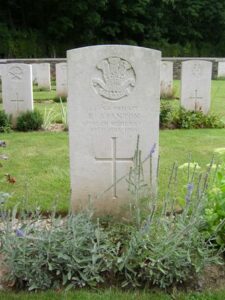
Albert William Teague, Gunner, 71809, Royal Garrison Artillery. Albert was born at Ludlow, the son of William and Elizabeth Teague. By 1911 the family was residing at Brynamman, before moving again to 4, Coelbren Road, Gwaun-Cae-Gurwen prior to the war. Albert was a colliery clerk prior to the war, and enlisted at Brynamman on 10 December 1915 into the Royal Garrison Artillery. On 13 August 1916 he sailed for France, joining the 233rd Siege Battery, Royal Garrison Artillery. Albert was wounded during the Batle of Arras, on 20 April 1917, and didn’t rejoin his battery for another two months. His Battery was by now at Ypres, and Albert was killed in action there during the build up to the Passchendaele Offensive, on 21 July 1917, aged 29. He is buried at Coxyde Military Cemetery, Belgium. Albert is not commemorated on the Brynamman Memorial, but is commemorated at Cwmamman.
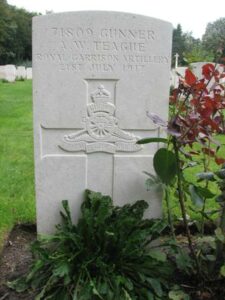
John Thomas, Private, 1452, Welsh Guards. John was the son of William and Mary Thomas, of Station Road, Brynamman, and was married, with a child. He enlisted into the 1st Battalion, Welsh Guards. The Welsh Guards had been formed by Royal Warrant on 26 February 1915, and by 18 August were ready to join the 3rd Guards Brigade, Guards Division in France. They landed in France in time to fight at the Battle of Loos, and then moved to the Somme, where they fought at Flers-Courcelette and Morval. They followed the German retreat to the Hindenburg Line, then moved to Ypres, where they took part in the Battles of Pilckem, the Menin Road, Poelcappelle and Passchendaele. John was Killed in Action at the First Battle of Passchendaele on 12 October 1917, aged 35. His body was lost on the battlefield, and so he is remembered on the Tyne Cot Memorial, Belgium.
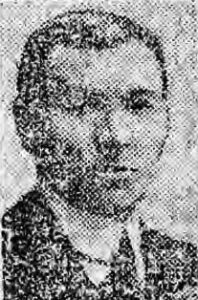
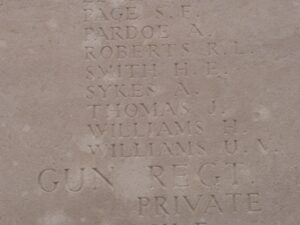
Richard Clement Thomas, Private, 59553, Welsh Regiment. Richard was the son of Richard and Margaret Thomas, of Station Road, Brynamman. He worked as a butcher prior to the war, and enlisted at Brynamman on 5 March 1917 into the Welsh Regiment. Richard landed in France on 31 July 1917, and on 17 August 1917 was attached to the 14th Battalion, Welsh Regiment, the Swansea Pals, who were in France attached to 114 Brigade, 38th (Welsh) Division. The Division had been in France since December 1915, and had famously captured Mametz Wood in July 1916. In July and August 1917 the Division captured the Pilckem Ridge, at Ypres, which is where Richard joined it. During the Winter of 1917-1918 the Division was near Armentieres, and it was here that Richard was killed by a shell on 28 January 1918. He was only 19 years old, and is buried at Aire Communal Cemetery, France.
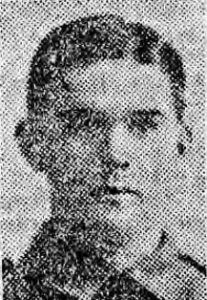
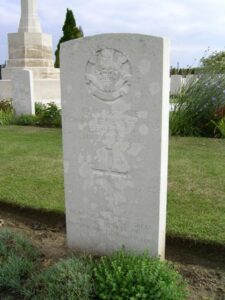
Reginald James Wakefield, Stoker 1st Class, K/16051, Royal Navy. Reginald was born at Cardiff on 26 January 1894, the son of James and Mary Teresa Wakefield. The family later resided at 45, Glyn Road, Lower Brynamman. He served in the Royal Navy, as a Stoker aboard His Majesty’s Submarine E49, and had gained the Serbian Silver Medal for Conspicuous Bravery. The submarine was commanded by Lieutenant B. A. Beal, and was operating in the North Sea, near the Shetland Islands, when she struck a mine on 12 March 1917. She sank with all hands, including Reginald, who was just 21 years old. He is remembered on the Plymouth Naval Memorial, Devon. The submarine lies 16 fathoms deep, with her bow blown off.
Gwyn Williams, Private, 31406, Royal Welsh Fusiliers. Gwyn was the son of John and Elizabeth Williams, of Brynawel, Llandilo Road, Brynamman. He enlisted at Ammanford on 8 June 1915 into the Royal Welsh Fusiliers, and joined the 16th Battalion, Royal Welsh Fusiliers at Llandudno two days later. The battalion was attached to 113 Brigade, 38th (Welsh) Division. After assembling in France in December 1915 the Division served in the French Flanders area, where they were initiated into trench warfare. Early in 1916 the division moved to positions at Givenchy, near Loos. Gwyn was one of several men from the division to be attached to the 173rd Tunnelling Company, Royal Engineers on 20 March 1916. Gwyn would have worked on mine galleries under the German lines at Givenchy for several weeks, and was killed in action here on 23 May 1916, aged 23. Gwyn is buried at Noeux-Les-Mines Communal Cemetery, France.
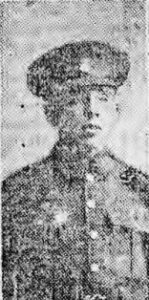
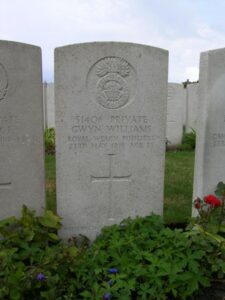
John Williams, Private, 42196, Suffolk Regiment. John was born at Llandeilo. He is named as a Brynamman man on the Carmarthen County War Memorial roll, and originally enlisted into the Training Reserve. John was posted to the 12th Battalion, Suffolk Regiment, which was attached to 121 Brigade, 40th (Bantam) Division. The Division moved to France in June 1916, and moved to the front near Loos. Late in 1916 they moved south to the Somme, and fought at the Battle of the Ancre, and remained in the area over the winter. In March 1917 the Germans withdrew to their shortened line, called the Hindenburg Line, and the 40th Division were one of the Divisions that followed the withdrawal. Later in the year they took part in the Battle of Cambrai, playing an important role in the attack on Bourlon Wood. They remained in the area over the coming months, but were caught here by the German Spring Offensive of 21 March 1918, and fought there at the Battle of St Quentin and retreating back westwards fought at the First Battle of Bapaume. Due to the terrible casualties suffered by the Division here they were sent north to Flanders to rest and rebuild, but in April the Germans launched an offensive in Flanders, and the 40th Division were caught up in the thick of it again, taking part in heavy fighting over the coming weeks. John was killed here on 9 April 1918. He is commemorated on the Ploegsteert Memorial, Belgium. John is not listed on the Brynamman War Memorial.
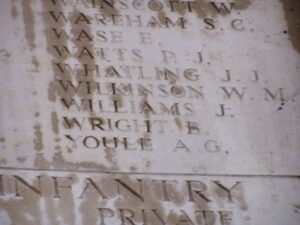
Herbert Ramsey Wood, Private, 13365, Welsh Regiment. Herbert (Bertie) was born in Swansea. He resided with his brother Robert at 19, Tinmans Row, Brynamman prior to the war, and had served for three years with the 3rd Welsh Volunteers prior to 1912. Bertie enlisted at Cardiff in December 1914 into the 8th Battalion, Welsh Regiment, which was the Pioneer Battalion to the 13th (Western) Division. The Division left the UK in June 1915 bound for Gallipoli, and landed at ANZAC Cove in early August that year. They saw some of the heaviest fighting at Gallipoli, at the Battle of Sari Bair, Russell’s Top and Hill 60, and were evacuated from the Peninsula on 8 January 1916. Bertie Died of Wounds suffered at Gallipoli on 19 November 1915. He is buried at Alexandria (Chatby) War Memorial Cemetery in Egypt. He probably suffered his wounds during the Battalions’ time at Suvla Bay.
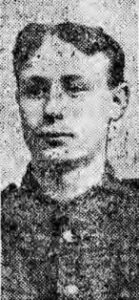
World War Two 1939-1945
Ernest Bartholomew, Flying Officer (Navigator), 145496, Royal Air Force Volunteer Reserve. Ernest was the son of Mr. and Mrs. Fred Bartholomew, of Lower Brynamman. He served in 25 Squadron, RAF, and was the Navigator on a training flight over Yorkshire when the aeroplane (a Mosquito) lost control and crashed in flames near West Flotmanby, Filey on 12 December 1943. Ernest and the Pilot, Colin Robertson D.F.C. were killed in the crash. Ernest’s body was recovered from the wreckage, and brought home for burial at Lower Brynamman (Siloam) Baptist Chapelyard. The photo is courtesy of Wendy Edwards.
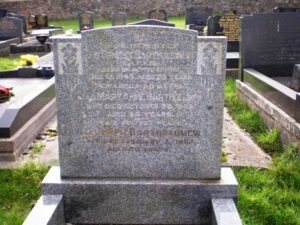
William Owen Callingham, Able Seaman, D/JX 165604, Royal Navy. William was the son of Frederick and Elizabeth Callingham, of Brynamman, and served in the Royal Navy aboard the aircraft carrier H.M.S. Eagle. She was armed with eighteen Fairey Swordfish torpedo bombers, taking part in the hunt for the Graf Spee before being deployed to the Mediterranean. Her aircraft took part in several audacious raids on Axis targets around the Med, and she was also used to ferry aircraft to the besieged island of Malta. Her final action was in August 1942 as cover for the Malta-bound convoy of Operation Pedestal. On the early morning of the 11th August she was hit by four torpedoes from U-73, Captained by Helmut Rosenbaum, and sank 70 nautical miles south of Cape Salinas. The majority of the crew survived and were picked from the sea by her escorts. One of the unfortunate men who died in the sinking was William. He was 24 years old and is remembered on the Plymouth Naval Memorial, Devon on Panel 64, Column 2.
David James Davey, Sergeant, 3961246, Welch Regiment. David was the son of Robert and Rachel Davey, and the husband of Elsie Elizabeth Davey, of Llangynwyd, Glamorgan. He served with the 1/5th Battalion, Welch Regiment, which was attached to the 53rd (Welsh) Division. The Division landed during the end of June 1944 in Normandy as part of the reinforcements to the invasion force, and subsequently fought their way out of Normandy, north through France and Belgium, and into Holland. David was killed in action in Holland on 7 October 1944, aged 23. He is buried at Valkenswaard War Cemetery.
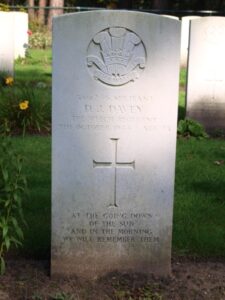
Gwilym Leonard Davies, Flying Officer (Navigator), 54259, Royal Air Force. Gwilym was the son of William Henry and Margaret Davies, of Brynamman. He married Kathleen Featherstone, of Grimsby, in 1939. He served with 281 Squadron, RAF, which was an Air-Sea Rescue Squadron which flew Defiant’s, the Supermarine Walrus and the Warwick amphibious planes. Gwilym was one of three men killed while flying aboard Sea Otter JM986 which flew into a cliff at Torr Head, County Antrim while on a transit flight from RAF Valley on 11 April 1945. He was 34 years old and is buried at Grimsby (Scartho Road) Cemetery.
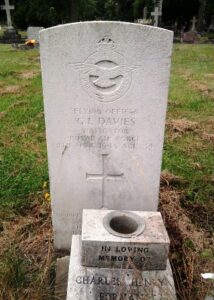
Thomas Henry Edwards, Serjeant, 2733455, Welsh Guards. Very little is known of Thomas, except that he served with the 1st Battalion, Welsh Guards. The Welsh Guards had been trapped in Northern France with the rest of the BEF when Germany invaded in 1940, and were the last British troops to leave Arras, which had been a British stronghold during the Great War. They fought a magnificent rearguard action north-east to Dunkirk where they were evacuated at the end of May, 1940. Thomas was probably wounded in France, and he died in Essex on 2 March 1941, aged 31. He is buried at Ilford (Barkingside) Cemetery.
Thomas Charles Evans, Private, 14541574, North Staffordshire Regiment. Again the only man who matches the name on the memorial is this man. Thomas was the son of Mr. and Mrs. Charles Lambert Evans, of Guilsfield, Montgomeryshire. He served with the 2nd Battalion, North Staffordshire Regiment, which was attached to the 2nd Infantry Brigade. They were present at the Fall of France in 1940 as part of the BEF, and were evacuated at the end of May 1940. They then moved to North Africa, where they fought throughout the Campaign in the Western Desert, and took part in the landings at Anzio in 1944. Thomas was killed in action at Anzio on 31 May 1944, and was buried at Beach Head War Cemetery, Anzio, Italy.
Thomas Wyndham Evans, Private, 5255505, Green Howards (Yorkshire Regiment). Thomas was the son of David Daniel and Lucretia Evans, of Brynamman, and served with the 6th Battalion, Green Howards. The Battalion were in France at the start of the war as part of the BEF, and took part in the retreat to, and the evacuation of, Dunkirk. The Battalion were then sent to North Africa, and fought during the campaign in the Western Desert. The Germans had effectively been beaten by May 1943, but Thomas died soon after, on 10 June 1943. He was 27 years old and is buried at Fayid War Cemetery, Egypt.
Frederick Lawford Gibson, Petty Officer, D/JX 135348, Royal Navy. Frederick was the son of Frederick Joseph and Louisa Gibson, of Upper Brynamman. He served in the Royal Navy, aboard H.M.S. Hastings, which was a Sloop that had been launched in April, 1930. Prior to the war she served in the Persian Gulf and the Red Sea, and returned to Home Waters in 1937 where she joined the Fishery Protection Squadron. In 1939 she was refitted, and fitted with ASDIC anti-submarine detectors, and was deployed in the North Sea. In October 1941 she moved from the Western Approaches to Londonderry, where she was deployed for Atlantic Convoy Defence and in February 1942 moved to West African Command, based at Freetown. In February 1943 she returned to Londonderry, which is where Frederick died on 27 March 1943. He was 27 years old and is buried at Londonderry City Cemetery.
David Gareth Griffiths, Sergeant, 1316486, Royal Air Force Volunteer Reserve. David was the son of David and Hannah Griffiths, of Brynamman, and served in 204 Squadron, RAFVR. The Squadron came under RAF Coastal Command, flying the Short Sunderland, and had begun the war based in Mount Batten, Devon. They moved to the Shetland Islands for a short period, and then spent 3 months at Iceland before moving to Gibraltar in July, 1941. In August 1941 they moved to Bathurst in Gambia, and the following year, were re-equipped with the Mark III Sunderland, which was a better armed and equipped aircraft than their previous version. David lost his life when his aircraft was lost on 18 July 1943. He was just 20 years old and is remembered on the Runnymede Memorial.
Margaret Mary Griffiths. There are two ladies of this name remembered by the Commonwealth War Graves Commission, neither of which have obvious links to Brynamman. On of which was a serving member of the Women’s Royal Voluntary Service, of St. Joseph’s, Wellesley Crescent. She was the Wife of Frank Sharpin Griffiths, and Died during a bombing raid at Wellesley Crescent on 29 November 1940 aged 54. The other lady was of Kensington House, Hazelbeach, Llanstadwell. She was the Daughter of C. H. Griffiths, and of Esther Muriel Griffiths, and died at Kensington House during an Air Raid, aged just 17.
Urwyn Harris, Private, 1796259, Northamptonshire Regiment. Urwyn was the son of David and Mary Harris, of Brynamman, and served with the 5th Battalion, Northamptonshire Regiment. The Battalion had served in the Western Desert Campaign in 1942 and 1943, and had taken part in the invasion of Italy. Urwyn was killed in Italy on 31 October, 1944 aged just 22 and is buried at Arezzo War Cemetery, Italy.
Thomas John, Marine, PLY/X. 105762, Royal Marines. Thomas was the son of Martin and Maggie Alice John, of Brynamman, and served with the Royal Marines. Very little is known of Thomas, but he was killed in Belgium on 1 November 1944, during the invasion of Hitler’s ‘Fortress Europe’, and is buried at Oostende New Communal Cemetery, Belgium. He was 24 years old.
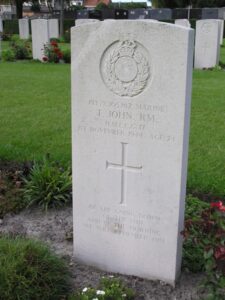
Gerwyn Jones, Craftsman, 10593898, Royal Electrical and Mechanical Engineers. Gerwyn was the son of David John and Deborah Jones, of Brynamman, and served in the Royal Electrical and Mechanical Engineers, with their 3rd A.A. Workshop Company. Very little is known at present about the unit, but Gerwyn died on 29 June 1945, aged 28 and is buried at Brynamman (Hermon) Congregational Chapelyard. Many thanks to Gareth Hicks for the photograph used below.
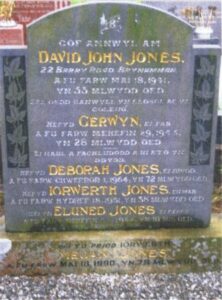
Griffith John Jones, Trooper, 7922755, Royal Tank Regiment. Griffith was the son of Thomas and Mary Ann Jones, of Brynamman, and served with the Royal Armoured Corps, in their 47th (Oldham), Royal Tank Regiment. The Battalion had been formed by the conversion of a Battalion of the Manchester Regiment’s Infantry to an armoured Battalion in 1938, and formed part of the Territorial Army. They fought in the Western Desert during the Battles of El Alamein in 1942, which is where Griffith was killed in action on the 27 October 1942. He was 32 years old and is buried at El Alamein War Cemetery, Egypt.
William Edison Jones, Able Seaman, D/JX 157998, Royal Navy. William was the son of David and Gwendoline Jones, of Brynamman, and served in the Royal Navy aboard HMS Gloucester. She was a Town class light cruisers, launched on 19 October 1937. Gloucester saw service in the early years of World War II, deployed initially to the Indian Ocean and later South Africa before joining Vice Admiral Cunningham’s Mediterranean fleet in 1940. She was sunk on 22 May 1941 during the Battle of Crete with the loss of 722 men out of a crew of 807. William was one of the dead. He was 19 years old, and is commemorated on Panel 47 of the Plymouth Naval Memorial, Devon.
Bertie Lewis. Cannot presently be identified.
Caradoc Lewis, Able Seaman, D/SSX 19940, Royal Navy. Very little is known about Caradoc, except that he served with the Royal Navy aboard H.M.S. Punjabi. She was a ‘Tribal Class’ Destroyer, that had been launched in December 1937. At the outbreak of war she served with the 6th Destroyer Flotilla in the North Sea, and took part in the Second Battle of Narvik in April, 1940. She took part in the hunt for the Bismarck in May 1941 before returning to Iceland to refuel. Caradoc was probably wounded during the Battle of Narvik, and brought to the Royal Naval Hospital at Plymouth, where he died on 21 April 1941. He is buried there, at Plymouth (Weston Mill) Cemetery.
James John Lewis, Leading Aircraftman (Air Gunner), 1027992, Royal Air Force Volunteer Reserve. James was the son of Jack and Elizabeth Gertrude Lewis, and the husband of Gertrude Lewis, of Brynamman. He enlisted into the Royal Air Force and after basic training was posted to No 8 Air Gunnery School in Scotland. On 6 October he was flying in a Blackburn Botha, serial L6435, on a training flight, when it crashed into high ground near Alness, Ross and Cromarty, Scotland, killing all of her crew. James was 25 years old when he died that day and was brought home for burial in Upper Brynamman (St. Catherine) Churchyard.
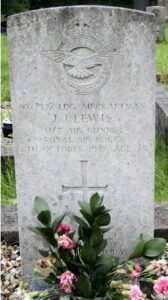
William Michael McGarry, Sergeant (Air Gunner), 1379359, Royal Air Force Volunteer Reserve. William served with 15 O.T.U., R.A.F., who was stationed at R.A.F. Harwell at the outbreak of war. The Squadron flew the Vickers Wellington Bomber in an operational training mode, and during 1940 and 1941 flew propaganda missions over France, and then flew bombing missions over Bremen, Cologne and Essen. The Airfield came under attack of the Luftwaffe during August and September 1941 and the Squadron were forced to move temporarily to R.A.F. Mount Farm while their runways were being repaired. William’s Wellington Ic, serial R1783 took from RAF Mount Farm at 19.05 on the night of 14/15 October 1941 tasked to fly to Orleans and Dreux on Nickeling duties, and due to enemy action crashed at Berville (Eure) 18km East of Lisieux. The crew of six men were killed, on 14 October 1941. William is buried at Barville Churchyard, France alongside his five other colleagues.
Owen Morgan, Driver, T/14300375, Royal Army Service Corps. Owen was the son of Llewellyn and Gladys Morgan, of Brynamman, and he served with 223 Air Despatch Company, Royal Army Service Corps. The Air Despatch Companies served world-wide on training, operation and famine relief duties. They were easily distinguishable from other units as they always wore their own Formation Sign, the golden Dakota on a Royal Blue background, wherever they were in the world. The Dakota flash was awarded to Air Despatch units following their part in ‘Operation Market Garden’ at Arnhem in September 1944. Air Despatchers suffered proportionally the highest casualties during the operation. It is probable that Owen was wounded during Market Garden, and he died at home on 21 September 1944, aged just 20. Owen is buried at Lower Brynamman (Ebenezer) Independent Burial Ground.
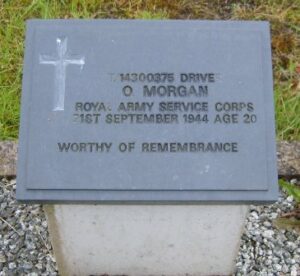
Dewi Marlais Nedhal, Flying Officer, 138211, Royal Air Force Volunteer Reserve. Dewi was the son of Roderick and Esther Nedahl, of Burry Port, and served with 255 Squadron, R.A.F.V.R. The Squadron were based at Lata in 1943 flying the Bristol Beaufighter VIF, based at Bo Rizzo, and Dewi was taking part in a flight on 26 September 1943, when his aircraft was lost. He was 22 years old and is remembered on the Malta Memorial.

David Phillips Pollard. David was born at Brynamman in 1915, the son of Thomas Gordon Pollard and Catherine Pollard (nee Phillips). Little can presently be traced of him, but he died in Cardiff in the summer of 1943, aged 27. He is not commemorated by the CWGC.
Donald B. Rees, Private, 78486, South African Forces. This is the only man whose name matches the memorial details. Donald was the son of John and Mary Rees, and the husband of Ada M. Rees, of Benoni, Transvaal, South Africa. He served with the Transvaal Scottish, South African Infantry in the Western Desert, and must have been taken prisoner at some time in the campaign, and moved to a POW Camp in Italy. Donald died in Italy on 23 November 1941, aged 31, and is buried at Knightsbridge War Cemetery, Acroma, Italy.
Arthur Edwin Rees, Sergeant, 934390, Royal Air Force Volunteer Reserve. Arthur was the son of Edwin Thomas Rees and Sarah Adelina Anne Rees (nee Jones), of Penygroes. He enlisted into the Royal Air Force Volunteer Reserve, and after completing his training as a Pilot was posted to 214 Squadron, RAF. The squadron was a heavy bomber unit, equipped the Vickers Wellington, based at RAF Stradishall. On 1 April 1942, Arthur took off from Stradishall aboard Wellington IC, Serial R1789, on an operational flight over Hanau, Germany, when it was shot down and crashed near Mannheim, Germany, in the early hours of 2 April 1942, killing all her crew of six. Arthur was 21-years-old when he was killed during the crash, and is buried alongside his fellow crew in Durnbach War Cemetery, Germany. His brother, James Gilbert Rees, had been killed at sea in 1940.
James Gilbert Rees, First Radio Officer, Merchant Navy. James was born at Upper Brynamman on 12 September 1913, the son of Edwin Thomas Rees and Sarah Adelina Anne Rees. He served with the Merchant Navy aboard the S.S. Harpalyce, a London registered cargo steamer. On 25 August 1940 she was off the Hebrides, returning from Halifax for Hull as part of Convoy HX-65A, carrying a cargo of 8000 tons of steel, when she was torpedoed and sunk by the German Submarine U-124, with the loss of 37 lives. James was 26 years old when he died that day, and is commemorated on the Tower Hill Memorial, London. His brother Arthur was killed in 1942.
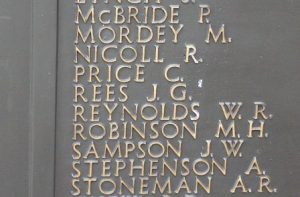
John Elwyn Rees, Able Seaman, D/JX 165627, Royal Navy. John was the son of Llewellyn and Rachel Rees, of Brynamman, and served in the Royal Navy aboard H.M. Submarine Stonehenge. She was an ‘S’ Class Submarine that had been launched in March 1943 and served in the Pacific, where she sank the Japanese merchant vessel Koryo Maru No.2 and the Japanese auxiliary minelayer Choko Maru. She left Trincomalee to patrol in the northern part of the Malacca Straits on 25 February 1944, but was reported missing after failing to arrive at Ceylon on 20 March as expected. It is not known for sure what caused her sinking, but a mine was considered to be the most likely explanation at the time. She was probably sunk by Japanese depth charges. John was lost in the disappearance of the Stonehenge on 20 March 1944, and is remembered on the Plymouth Naval Memorial, Devon.
Lewis Howell Rees, Corporal, 5187579, Gloucestershire Regiment. Lewis was the son of Bryn and Rachel Rees, of Brynamman, and served with the 1st Battalion, Gloucestershire Regiment. The Battalion served in the Far East, during the Japanese invasion of Burma, Lewis was killed in Burma on 2 April 1942, aged 23, and is remembered on the Rangoon Memorial, Burma.
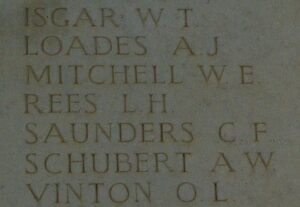
Comber Richards, Private, 4625941, Pioneer Corps. Again, very little is known of Comber, but he served with the Pioneer Corps, and died at Abergavenny on 23 March 1945, aged 34. He is buried at Lower Brynamman (Ebenezer) Independent Burial Ground.
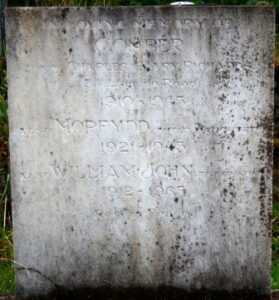
Donald Robinson, Trooper, 7941591, Royal Armoured Corps. Donald was the son of Dilys Hurley, of Lower Brynamman, and served with the Head Quarters of the 1st Armoured Brigade. Donald was killed in Greece on 8 January 1945, aged 23, and is buried at Phaleron War Cemetery, Greece.